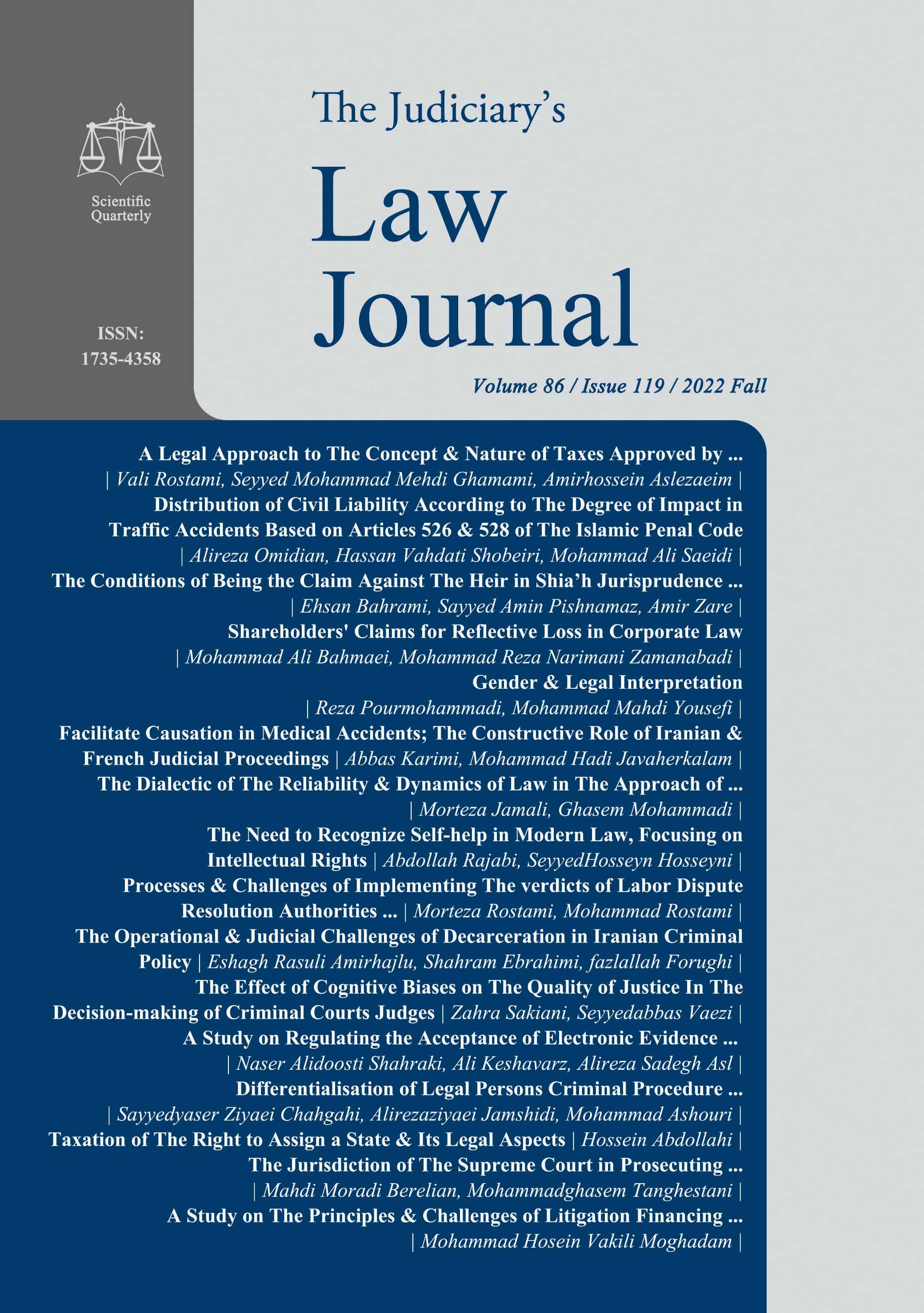Document Type : Research/Original/Regular Article
Authors
Doctoral student of Criminal Law and Criminology, School of Law and Political Science, University of Tehran, Tehran, Iran
Abstract
It is obvious that a large part of the quality of a judicial system depends on the quality of the decisions that judges make. Even judges with high experience and knowledge may make some mistakes, but it is expected that judges do not make systematic mistakes. However, despite the fact that, based on the results of some studies in the field of behavioural economics, in various parts of judicial decision-making, including discovering the facts of the case, assigning criminal responsibility, and especially determining the punishment for criminals, there may be factors that influence the decision-making of judges, which from a normative and logical point of view should not be. Behavioural economics is a branch of economics that tries to make economic assumptions more realistic by using sciences such as psychology and sociology. So describing judicial decisions by using cognitive biases make it closer to the field of criminal sociology and judicial psychology. Recognizing that factors beyond legal issues can influence judicial decisions and judges' behaviours provides the basis for interdisciplinary approaches to explaining judicial decisions and judges' behaviour. This descriptive-analytical article seeks to explain the above factors and identify possible solutions to improve judicial decisions and increase judicial justice. The proposed solutions can be summarized in the form of in-service training of judges and a more appropriate architecture of decision-making structures.
Keywords
Main Subjects
فارسی
- ارونسون، الیوت (۱۳۸۵)، روانشناسی اجتماعی، ترجمه: حسین شکرکن، چاپ هجدهم، ویرایش هشتم، تهران: انتشارات رشد.
- امیری، علی، جواد طهماسبی و بتول پاکزاد (1399)، «کاربرد مدیریت ارجاع در تضمین دادرسی بیطرفانه کیفری»، مجله حقوقی دادگستری، دوره 85، شماره 114.
- بارون، رابرت، دان بیرن و نایلا برنسکامب (۱۳۹۹)، روانشناسی اجتماعی، ترجمه دکتر یوسف کریمی، چاپ چهاردهم، تهران: نشر روان.
- بهرهمند، حمید و زهرا ساکیانی (۱۴۰۰)، «تصمیمگیری مجرمان از منظر اقتصاد رفتاری و دلالتهای آن در سیاستگذاری کیفری»، مجله حقوقی دادگستری، دوره ۸۵، شماره ۱۱۵.
- تالر، ریچارد و کاس سانستین (۱۳۹۷)، سقلمه بهبود تصمیمات درباره تندرستی، ثروت و خوشبختی، ترجمه مهری مدآبادی، تهران: نشر هورمزد.
- رابرتز، جولیان، لورتا استالاتز، دیوید ایندرمار و مایک هاف (۱۳۹۲)، عوامگرایی کیفری و افکار عمومی، درسهایی از پنج کشور، ترجمه زینب باقرینژاد، سودابه رضوانی، مهدی کاظمی جویباری و هانیه هژبرالساداتی، تهران: نشر میزان.
- راسخ، محمد و سیدحمید پورسید آقایی (1395)، «نگاهی انتقادی به شکلگرایی در حقوق»، فصلنامه تحقیقات حقوقی، دوره 19، شماره 74.
- سبزوارینژاد، حجت و مهدی سبزوارینژاد (1395)، دوره کامل حقوق جزای عمومی، تهران: انتشارات مجد.
- کلانتری، کیومرث و عباس سلمانپور (1398)، «جایگاه علم قاضی در اثبات امر کیفری در حقوق ایران»، پژوهشنامه حقوق کیفری، دوره 10، شماره 2.
- هالپرن، دیوید (۱۳۹۸)، تلنگرچی در واحد تلنگر، ترجمه بهنام شهائی، تهران: مؤسسه کتاب مهربان نشر.
انگلیسی
- Berger, L. L. (2013). A revised view of the judicial hunch. Legal Comm. & Rhetoric: JAWLD, 10, 1.
- Danziger, S., Levav, J., & Avnaim-Pesso, L. (2011). Extraneous factors in judicial decisions, Proceedings of the National Academy of Sciences, 108 (17).
- Epstein, L., Landes, W., Posner, R. (2013), The Behavior of Federal Judges_ A Theoretical and Empirical Study of Rational Choice, harvard university press.
- Fischhoff, B. (2003). Hindsight≠ foresight: the effect of outcome knowledge on judgment under uncertainty. BMJ Quality & Safety, 12 (4).
- Guilbault, R. L., Bryant, F. B., Brockway, J. H., & Posavac, E. J. (2004). A meta-analysis of research on hindsight bias. Basic and applied social psychology, 26 (2-3).
- Pi, D., Parisi, F., & Luppi, B. (2014). Biasing, debiasing, and the law., in the oxford handbook of behavioral economics and the law, edited by Eyal Zamir and Doron Teichman.
- Guthrie, C., Rachlinski, J. J., & Wistrich, A. J. (2000). Inside the judicial mind. Cornell L. Rev., 86.
- Holyoak, K. J., & Simon, D. (1999). Bidirectional reasoning in decision making by constraint satisfaction. Journal of Experimental Psychology: General, 128 (1).
- Leibovitch, A. (2016a), Relative Judgment, The Journal of Legal Studies, 45 (2).
- Leibovitch, A. (2016b). Punishing on a Curve. UL Rev., 111.
- Leiter, B. (2010). Legal formalism and legal realism: what is the issue. Legal theory, 16 (2).
- Lockton, D. (2012), cognitive biases, heuristics and decision-making in design for behavior changes, SSRN electronic journal. 10.2139/ssrn.2124557.
- Lord, C. G., Lepper, M. R., & Preston, E. (1984). Considering the opposite: a corrective strategy for social judgment. Journal of personality and social psychology, 47 (6).
- Nario, M. R., & Branscombe, N. R. (1995). Comparison processes in hindsight and causal attribution. Personality and Social Psychology Bulletin, 21 (12).
- Slovic, P., Peters, E., Finucane, M. L., & MacGregor, D. G. (2005), Affect, risk, and decision making, Health psychology, 24 (4S), 35-40.
- Teichman, D., Zamir, E. (2014), judicial decision-making a behavioral perspective, in the oxford handbook of behavioral economics and the law, edited by Eyal Zamir and Doron Teichman.
- Ulmer, J. T., & Johnson, B. (2004). Sentencing in context: A multilevel analysis, Criminology, 42 (1).
- Zamir, E., Teichman, D. (2018), Behavioral Law and Economics, Oxford University Press.

